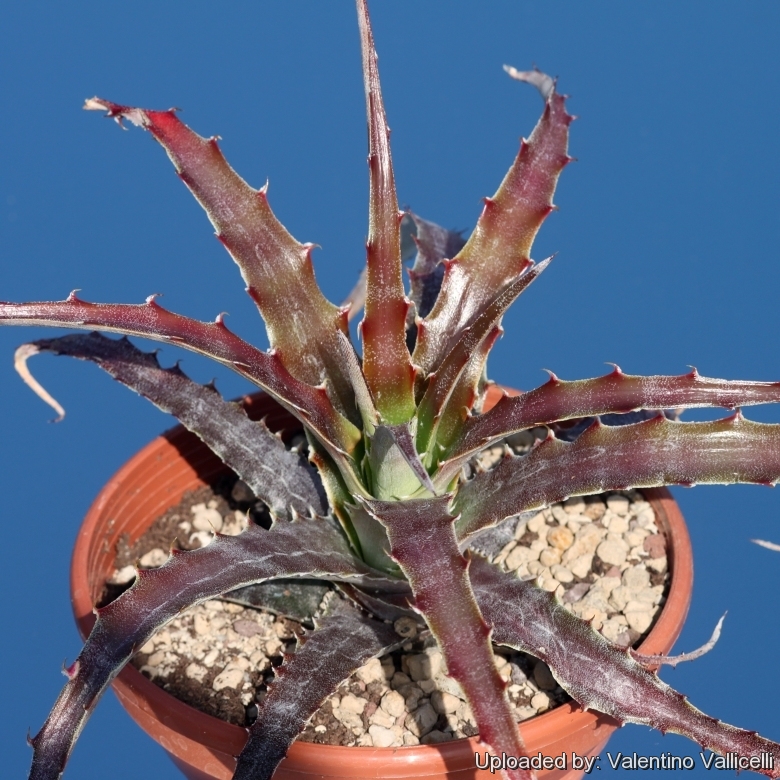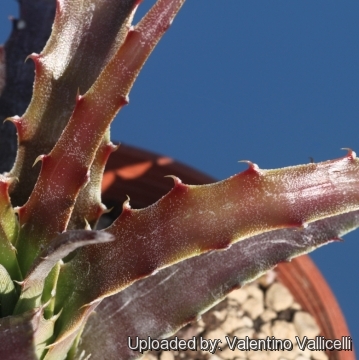
Hechtia sp. Miahuatlan, Oaxaca, Mexico Photo by: Valentino Vallicelli
Origin and Habitat: Miahuatlan, Oaxaca, Mexico.
Synonyms:
Description: This is a beautiful species with colourful rosettes.
Leaves: In basal rosettes, glossy-green or grayish green on the upper surfaces dark purple-shaded if exposed to intense light and covered with an uneven coat of white scales and armed with well spaced heavy spines at the margins, narrow and pointed inward. The upper side is slightly variegated, under side of an ashy silvery.
Flower: The inflorescence is a compound spike.
 Hechtia sp. Miahuatlan, Oaxaca, Mexico Photo by: Valentino Vallicelli
Hechtia sp. Miahuatlan, Oaxaca, Mexico Photo by: Valentino VallicelliSend a photo of this plant.The gallery now contains thousands of pictures, however it is possible to do even more. We are, of course, seeking photos of species not yet shown in the gallery but not only that, we are also looking for better pictures than those already present.
Read More... Cultivation and Propagation: It is a compact and carefree fast growing bromeliad particularly ornamental most of the year.
Growing substrate: This bromeliad needs a well drained soil mix comprising equal parts of well rotted compost, coarse river sand (or pumice) and loam and can remain in the same position for many years.
Watering: It enjoys regular moisture, once per week during the summer growing period, but reduce watering in winter to once every two or four weeks, but it’s very tough and drought tolerant. Requires complete and perfect drainage. Give it excellent drainage.
Feeding: Apply a very weak liquid feed every month or so over the growing season and a mild solutions (one-quartet strength) of foliar fertilizer at 3-month intervals to both garden and container plants.
Hardiness: USDA Zones: 9-11, Hardy to -6° C. North of Zone 9, this bromeliad is grown in containers that must be overwintered indoors.
Pest & diseases: No serious insect or disease problems. Watch for aphids and scale. Mealybugs infestations are also a frequent problem. Rot may develop if soil is kept too moist.
Tip: Remove old leaves from plant base and dead flower spikes only. Remove older plant crown when it begins to fade. Container grown plants should be re-potted every other year for good growth when new growth starts in the spring, but only need to be divided every seven or eight years when flowering performance starts to diminish.
Warning: Plant has spines or sharp edges that deter some gardeners; use extreme caution when handling.
Use: In warm and temperate climates grow it as a groundcover or accent in desert or alpine gardens, mixed borders, courtyard gardens, raised beds and rockeries. The plant makes a good potted plant and can also be cultivated as a house plant or patio container filler.
Propagation: It is propagated by division of offsets and from seed. The offsets can be detached and repotted when they have reached the dimension of one third of the mother plant. Be sure to provide high humidity for a month after propagating the offsets. Fresh seed germinates in as little as 14 days from sowing. Remove seeds from inflorescence and lay them uncovered on a bed of of pumice grit; keep constantly but moderately moist. Starting from the seed, 2-4 years are needed for the blossoming, whilst at least 2 years are needed by division.










